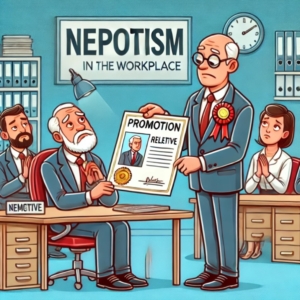
Mergers and acquisitions (M&A) are complex processes that require careful planning, strategic alignment, and cultural integration. One often-overlooked factor that can derail even the most promising mergers is nepotism. While it may seem like an innocuous practice, nepotism can introduce a host of challenges that can erode trust, stifle innovation, and ultimately undermine the success of the merger.
1. Erosion of Employee Morale
One of the most significant risks associated with nepotism is the negative impact on employee morale. When employees perceive that positions are being filled based on familial or personal relationships rather than merit, it creates an environment of distrust and resentment. Talented employees may feel undervalued and overlooked, leading to disengagement and even turnover.
Hypothetical Example 1: In a recent merger, a highly qualified senior manager was passed over for promotion in favor of the CEO’s nephew, who lacked experience in the industry. As a result, several key employees resigned, citing frustration with the lack of recognition for their contributions. Productivity declined, and the company struggled to retain top talent.
Hypothetical Example 2: An experienced HR manager discovered that key performance metrics were ignored when a relative of the executive team was promoted, leading to widespread discontent and a drop in overall productivity.
2. Undermining of Meritocracy
Mergers often bring together two distinct corporate cultures, each with its own values and expectations. A commitment to meritocracy—where performance and competence dictate career advancement—is essential for fostering a productive and collaborative workplace. Nepotism undermines this principle by promoting individuals based on relationships rather than qualifications, leading to inefficiencies and potentially poor decision-making.
Hypothetical Example 1: After a merger, a family member of the acquiring company’s CEO was placed in charge of the finance department despite lacking the necessary financial acumen. This led to multiple budgeting errors and poor financial planning, resulting in lost revenue and a damaged reputation with investors.
Hypothetical Example 2: A junior employee, related to the COO, was given oversight of critical operations despite having little prior experience, causing confusion and inefficiencies across departments.
3. Resistance to Change
Successful mergers require adaptability and a willingness to embrace change. When nepotism is present, entrenched family dynamics or personal loyalties can create resistance to new ideas and processes. Family members or close associates in key positions may prioritize personal interests over the broader goals of the merged entity, slowing down critical integration efforts and hindering progress.
Hypothetical Example 1: A newly appointed operations director, the brother-in-law of the COO, resisted implementing a modern inventory management system, preferring outdated methods he was more comfortable with. This resulted in operational inefficiencies and delays that negatively impacted customer satisfaction.
Hypothetical Example 2: A long-time family friend placed in a leadership position blocked restructuring efforts that could have improved company performance, citing loyalty to past ways of doing business.
4. Legal and Compliance Risks
Beyond the internal cultural challenges, nepotism can also pose significant legal and compliance risks. Favoring family members for positions without proper hiring protocols can lead to accusations of discrimination or favoritism, potentially resulting in legal disputes and reputational damage. Organizations undergoing M&A must adhere to strict regulatory frameworks and governance standards, making it crucial to avoid any perception of impropriety.
Hypothetical Example 1: An employee filed a lawsuit against the company after learning that a relative of the CEO was hired for a senior role without going through the standard recruitment process. The legal battle resulted in hefty fines and a tarnished public image, discouraging potential business partners.
Hypothetical Example 2: Regulatory authorities launched an investigation after whistleblower complaints about biased hiring practices favoring family members, leading to potential financial penalties and negative press.
5. Damage to Brand and Reputation
The perception of nepotism can tarnish the reputation of the newly merged company in the eyes of stakeholders, including customers, investors, and potential partners. Transparency and fairness are critical components of a strong corporate reputation, and any indication of favoritism can lead to a loss of confidence in leadership and the company’s long-term viability.
Hypothetical Example 1: A publicized case of nepotism in a merger led to negative media coverage, causing customers to question the company’s ethics. As a result, the company saw a decline in sales and investor trust, which took years to rebuild.
Hypothetical Example 2: Disgruntled employees took to social media to expose favoritism within the company, resulting in widespread criticism and loss of potential business opportunities.
The Importance of Promoting from Within
Promoting from within fosters a culture of growth, stability, and motivation among employees. When employees see a clear path for advancement based on performance, they are more likely to remain engaged and committed to the company’s success. Clearly defined roles, performance metrics, and career paths provide transparency and reinforce the notion that promotions are objective and merit-based.
Key Benefits of Internal Promotions:
– Employee Retention: Providing internal growth opportunities reduces turnover and enhances loyalty.
– Cost Efficiency: Internal candidates require less training and onboarding, saving time and resources.
– Cultural Continuity: Employees who rise through the ranks already understand the company culture and values.
– Motivation and Productivity: Transparent promotion paths inspire employees to perform at their best, knowing their efforts will be rewarded fairly.
Hypothetical Example: A merger resulted in a clear career advancement framework, allowing an experienced project manager to be promoted to a senior leadership role based on predefined performance criteria. This move not only increased employee satisfaction but also ensured the continuation of company culture and strategic objectives.
Strategies to Mitigate Nepotism Risks in M&A
To ensure a successful merger, organizations must proactively address nepotism by implementing the following strategies:
– Establish Clear Governance Policies: Develop and enforce policies that outline objective hiring and promotion criteria.
– Promote a Culture of Transparency: Communicate openly about the importance of merit-based decisions and hold leadership accountable.
– Conduct Independent Audits: Engage third-party auditors to review hiring and promotion practices to ensure fairness.
– Foster Inclusive Leadership: Encourage diverse perspectives and leadership styles to counterbalance any existing biases.
Summary
In the world of mergers and acquisitions, the presence of nepotism can create significant hurdles to achieving strategic objectives. By fostering a culture of fairness, transparency, and meritocracy, organizations can unlock the full potential of their workforce and position themselves for long-term success. Addressing nepotism head-on is not just a best practice—it’s a necessity for sustainable growth and integration.





